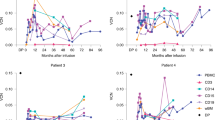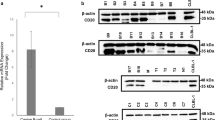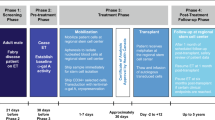Abstract
Canine leukocyte adhesion deficiency (CLAD) provides a unique large animal model for testing new therapeutic approaches for the treatment of children with leukocyte adhesion deficiency (LAD). In our CLAD model, we examined two different fragments of the human elongation factor 1α (EF1α) promoter (EF1αL, 1189 bp and EF1αS, 233 bp) driving the expression of canine CD18 in a self-inactivating (SIN) lentiviral vector. The EF1αS vector resulted in the highest levels of canine CD18 expression in CLAD CD34+ cells in vitro. Subsequently, autologous CD34+ bone marrow cells from four CLAD pups were transduced with the EF1αS vector and infused following a non-myeloablative dose of 200 cGy total-body irradiation. None of the CLAD pups achieved levels of circulating CD18+ neutrophils sufficient to reverse the CLAD phenotype, and all four animals were euthanized because of infections within 9 weeks of treatment. These results indicate that the EF1αS promoter-driven CD18 expression in the context of a RRLSIN lentiviral vector does not lead to sufficient numbers of CD18+ neutrophils in vivo to reverse the CLAD phenotype when used in a non-myeloablative transplant regimen in dogs.
This is a preview of subscription content, access via your institution
Access options
Subscribe to this journal
Receive 6 print issues and online access
$259.00 per year
only $43.17 per issue
Buy this article
- Purchase on SpringerLink
- Instant access to full article PDF
Prices may be subject to local taxes which are calculated during checkout



Similar content being viewed by others
References
Trowald-Wigh G, Hakansson L, Johannisson A, Norrgren L, Hard af Segerstad C . Leucocyte adhesion protein deficiency in Irish setter dogs. Vet Immunol Immunopathol 1992; 32: 261–280.
Creevy KE, Bauer Jr TR, Tuschong LM, Embree LJ, Colenda L, Cogan K et al. Canine leukocyte adhesion deficiency colony for investigation of novel hematopoietic therapies. Vet Immunol Immunopathol 2003; 94: 11–22.
Kijas JM, Bauer Jr TR, Gafvert S, Marklund S, Trowald-Wigh G, Johannisson A et al. A missense mutation in the β2 integrin gene (ITGB2) causes canine leukocyte adhesion deficiency. Genomics 1999; 61: 101–107.
Bauer Jr TR, Hai M, Tuschong LM, Burkholder TH, Gu YC, Sokolic RA et al. Correction of the disease phenotype in canine leukocyte adhesion deficiency using ex vivo hematopoietic stem cell gene therapy. Blood 2006; 108: 3313–3320.
Bauer Jr TR, Allen JM, Hai M, Tuschong LM, Khan IF, Olson EM et al. Successful treatment of canine leukocyte adhesion deficiency by foamy virus vectors. Nat Med 2008; 14: 93–97.
Hacein-Bey-Abina S, Von Kalle C, Schmidt M, McCormack MP, Wulffraat N, Leboulch P et al. LMO2-associated clonal T cell proliferation in two patients after gene therapy for SCID-X1. Science 2003; 302: 415–419.
Ott MG, Schmidt M, Schwarzwaelder K, Stein S, Siler U, Koehl U et al. Correction of X-linked chronic granulomatous disease by gene therapy, augmented by insertional activation of MDS1-EVI1, PRDM16 or SETBP1. Nat Med 2006; 12: 401–409.
Zychlinski D, Schambach A, Modlich U, Maetzig T, Meyer J, Grassman E et al. Physiological promoters reduce the genotoxic risk of integrating gene vectors. Mol Ther 2008; 16: 718–725.
Kim DW, Uetsuki T, Kaziro Y, Yamaguchi N, Sugano S . Use of the human elongation factor 1 alpha promoter as a versatile and efficient expression system. Gene 1990; 91: 217–223.
Ye ZQ, Qiu P, Burkholder JK, Turner J, Culp J, Roberts T et al. Cytokine transgene expression and promoter usage in primary CD34+ cells using particle-mediated gene delivery. Hum Gene Ther 1998; 9: 2197–2205.
Mikkola H, Woods NB, Sjogren M, Helgadottir H, Hamaguchi I, Jacobsen SE et al. Lentivirus gene transfer in murine hematopoietic progenitor cells is compromised by a delay in proviral integration and results in transduction mosaicism and heterogeneous gene expression in progeny cells. J Virol 2000; 74: 11911–11918.
Ramezani A, Hawley TS, Hawley RG . Lentiviral vectors for enhanced gene expression in human hematopoietic cells. Mol Ther 2000; 2: 458–469.
Salmon P, Kindler V, Ducrey O, Chapuis B, Zubler RH, Trono D . High-level transgene expression in human hematopoietic progenitors and differentiated blood lineages after transduction with improved lentiviral vectors. Blood 2000; 96: 3392–3398.
Taboit-Dameron F, Malassagne B, Viglietta C, Puissant C, Leroux-Coyau M, Chereau C et al. Association of the 5′HS4 sequence of the chicken beta-globin locus control region with human EF1 alpha gene promoter induces ubiquitous and high expression of human CD55 and CD59 cDNAs in transgenic rabbits. Transgenic Res 1999; 8: 223–235.
Bauer Jr TR, Miller AD, Hickstein DD . Improved transfer of the leukocyte integrin CD18 subunit into hematopoietic cell lines by using retroviral vectors having a gibbon ape leukemia virus envelope. Blood 1995; 86: 2379–2387.
Back AL, Kwok WW, Adam M, Collins SJ, Hickstein DD . Retroviral-mediated gene transfer of the leukocyte integrin CD18 subunit. Biochem Biophys Res Commun 1990; 171: 787–795.
Bauer Jr TR, Creevy KE, Gu YC, Tuschong LM, Donahue RE, Metzger ME et al. Very low levels of donor CD18+ neutrophils following allogeneic hematopoietic stem cell transplantation reverse the disease phenotype in canine leukocyte adhesion deficiency. Blood 2004; 103: 3582–3589.
Gu YC, Bauer TR, Sokolic RA, Hai M, Tuschong LM, Burkholder T et al. Conversion of the severe to the moderate disease phenotype with donor leukocyte microchimerism in canine leukocyte adhesion deficiency. Bone Marrow Transplant 2006; 37: 607–614.
Chang AH, Stephan MT, Sadelain M . Stem cell-derived erythroid cells mediate long-term systemic protein delivery. Nat Biotechnol 2006; 24: 1017–1021.
Acknowledgements
This research was supported by the Intramural Research Program of the NIH, National Cancer Institute, Center for Cancer Research. We thank William Telford and Veena Kapoor, NCI, for assistance with flow cytometry.
Author information
Authors and Affiliations
Corresponding author
Ethics declarations
Competing interests
The authors declare no conflict of interest.
Rights and permissions
About this article
Cite this article
Nelson, E., Tuschong, L., Hunter, M. et al. Lentiviral vectors incorporating a human elongation factor 1α promoter for the treatment of canine leukocyte adhesion deficiency. Gene Ther 17, 672–677 (2010). https://doi.org/10.1038/gt.2010.7
Received:
Revised:
Accepted:
Published:
Issue date:
DOI: https://doi.org/10.1038/gt.2010.7
Keywords
This article is cited by
-
Plaque associated microglia hyper-secrete extracellular vesicles and accelerate tau propagation in a humanized APP mouse model
Molecular Neurodegeneration (2021)
-
Gene transfer into hematopoietic stem cells as treatment for primary immunodeficiency diseases
International Journal of Hematology (2014)
-
Gene therapy in India: A focus
Journal of Biosciences (2014)
-
Long-Term Follow-up of Foamy Viral Vector-Mediated Gene Therapy for Canine Leukocyte Adhesion Deficiency
Molecular Therapy (2013)
-
Gene Therapy of Canine Leukocyte Adhesion Deficiency Using Lentiviral Vectors With Human CD11b and CD18 Promoters Driving Canine CD18 Expression
Molecular Therapy (2011)



